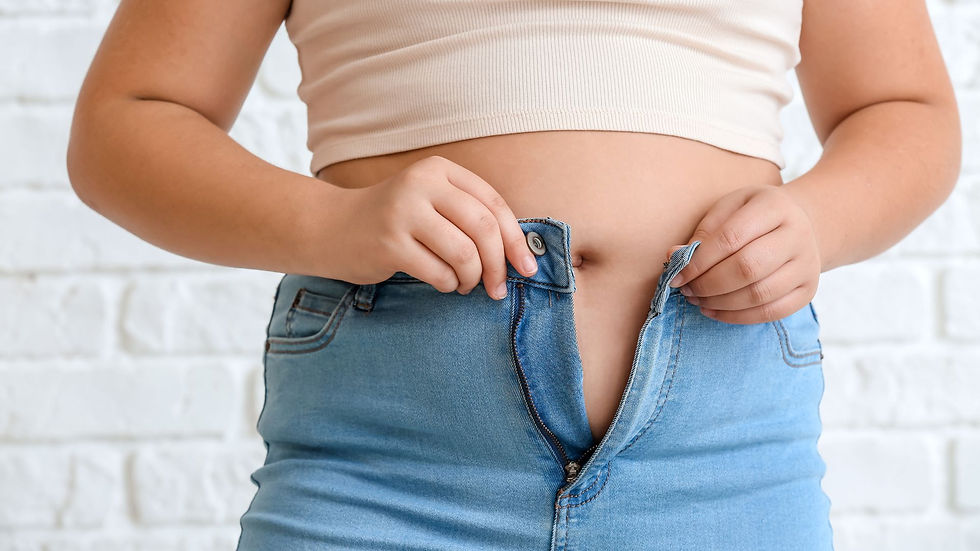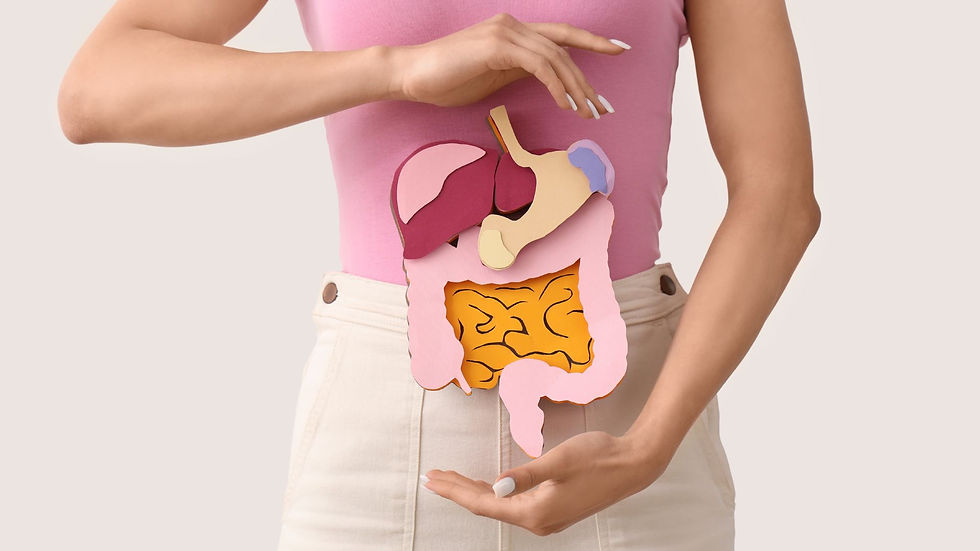Understanding and Addressing Menobelly: Your Guide to Managing Abdominal Fat in Menopause
- Victoria Harris
- Mar 20
- 4 min read
Navigating menopause comes with a lot of changes—some expected, and others, like the sudden appearance of abdominal fat (often called “menobelly”), can seem a bit of a surprise!
It’s not just about gaining a few pounds, but rather a shift in fat distribution that can impact your overall health.
The good news? Understanding the reasons behind it and taking action can make a huge difference in feeling your best.

The Hormonal Shifts Behind Menobelly
The primary reason for the increase in belly fat during menopause comes from the changes in hormones, especially the drop in estrogen. Before menopause, estrogen helps store fat around your hips, thighs, and breasts, giving you a “pear-shaped” body. However, as estrogen levels drop, fat tends to accumulate around the abdomen instead, leading to a more “apple-shaped” body.
Along with estrogen, testosterone, which is also produced by your ovaries and adrenal glands, becomes more influential. This shift can lead to fat storing itself in the belly area, just like it does for men. These hormonal changes also affect appetite control—lower estrogen levels can decrease leptin (the hormone that tells you when you’re full) and increase ghrelin (the hunger hormone). This may result in cravings and overeating, contributing to increased belly fat.
What’s Really Going on with Visceral Fat?
So, what’s actually happening when menobelly appears? The answer lies in visceral fat, a type of fat that accumulates deep inside your abdomen around important organs like the liver and intestines. Unlike the fat you can pinch (called subcutaneous fat), visceral fat is the more concerning one. It’s metabolically active and releases hormones and inflammatory substances that can negatively affect your body’s functions and increase the risk of serious health issues.

Here’s a fun way to assess if you might have excess visceral fat: the Hip-to-Waist Ratio (HWR)! This simple measurement can give you a good idea of your fat distribution:
Measure your waist at its narrowest point.
Measure your hips at their widest point.
Divide your waist measurement by your hip measurement.
For women, a ratio of 0.85 or higher is generally considered to indicate a higher risk of visceral fat. Keep an eye on that ratio—it’s a quick way to know where you stand!
Why Does Menobelly Happen, Even When Habits Stay the Same?
If you’re wondering why menobelly can appear even if you haven’t changed your diet or exercise routine, you're not alone! As we age and enter menopause, our metabolism naturally slows down. This means the body burns fewer calories at rest, making it easier to gain weight, even if you’re eating the same as before. Estrogen’s decline also leads to muscle loss. Since muscle burns more calories than fat, this muscle loss can further slow your metabolism, making weight gain more likely.
These hormonal shifts happen whether you change your lifestyle or not, and they explain why belly fat may accumulate even when you're staying active and eating well.
Bright and Simple Strategies to Manage Menobelly
While it’s totally normal to experience changes in body shape during menopause, there are many easy and fun ways to take control and feel your best:
Eat a Anti-Inflammatory Diet: Focusing on whole foods—fruits, vegetables, lean proteins, and whole grains—can help manage weight and reduce abdominal fat. Limiting processed foods and sugary drinks is key. And don’t forget about fiber! It helps keep you full and regulates blood sugar.
Exercise Regularly: I recommend different forms of exercise based off your body type. However, you can assess the styles of exercise below and see if one works for you! Examples are combining aerobic exercise (like walking, swimming, or cycling) with strength training to keep your muscles active and your metabolism burning! High-Intensity Interval Training (HIIT) is great for burning calories, and Pilates helps strengthen your core. Aim for at least 150 minutes of moderate-intensity aerobic activity per week and strength training twice a week.
Prioritize Sleep and Stress Management: Quality sleep is crucial. It helps regulate the hormones that control appetite and fat storage. Aim for 7-9 hours each night. Stress can also increase cortisol (the stress hormone), which promotes fat storage, so managing stress through yoga, meditation, or just spending time outside can be super helpful!
Cut Back on Alcohol and Quit Smoking: Both alcohol and smoking can contribute to belly fat. Cutting back on alcohol and quitting smoking can reduce your risk of gaining weight and help you feel better overall.
Why Visceral Fat Is More Than Just a Cosmetic Issue
It’s not just about how you look—excess visceral fat is linked to serious health concerns, like:
Heart disease
Type 2 diabetes
Stroke
High blood pressure
Certain cancers (breast, colon, and endometrial)
Cognitive decline and dementia
Visceral fat is especially dangerous because it’s metabolically active, producing substances that contribute to inflammation in the body, which plays a role in the development of many of these diseases and common menopause symptoms. Keeping an eye on your waistline and practicing healthy habits can help reduce these risks.

Final Thoughts: Empower Yourself During Menopause
While menobelly can feel frustrating, remember that it's completely natural and manageable. With the right strategies in place—like eating well, staying active, prioritizing sleep, and managing stress—you can easily take control and feel your best during this stage of life with the right protocols.
Now that you know what’s happening behind the scenes, take the time to measure your waist-to-hip ratio and implement some of these lifestyle changes. You’ll be on your way to managing abdominal fat and improving your overall health in no time!
Menopause doesn’t have to mean feeling uncomfortable in your body—it's just a new chapter. Embrace it with the right tools and knowledge, and you’ll be empowered to navigate these changes with confidence. You've got this!



